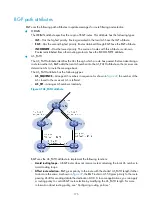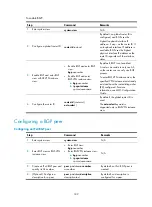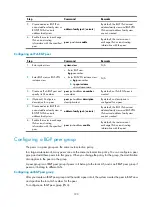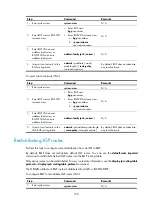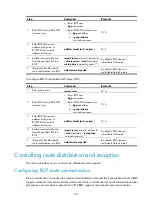
188
Tasks at a glance
Remarks
Controlling BGP path selection
•
Specifying a preferred value for routes received
•
Configuring preferences for BGP routes
•
Configuring the default local preference
•
•
Configuring the NEXT_HOP attribute
•
Configuring the AS_PATH attribute
N/A
Tuning and optimizing BGP networks
:
•
Configuring the keepalive interval and hold time
•
Configuring the interval for sending updates for the same route
•
Enabling BGP to establish an EBGP session over multiple hops
•
Enabling immediate reestablishment of direct EBGP connections upon link failure
•
Enabling 4-byte AS number suppression
•
Enabling MD5 authentication for BGP peers
•
Configuring BGP load balancing
•
Configuring IPsec for IPv6 BGP
•
•
Protecting an EBGP peer when memory usage reaches level 2 threshold
N/A
Configuring a large-scale BGP network
:
•
•
Configuring BGP route reflection
•
Configuring a BGP confederation
N/A
Enabling SNMP notifications for BGP
N/A
Enabling logging of session state changes
N/A
Configuring basic BGP
This section describes the basic settings required for a BGP network to run.
Enabling BGP
A router ID is the unique identifier of a BGP router in an AS.
•
To ensure the uniqueness of a router ID and enhance availability, specify in BGP view the IP address
of a local loopback interface as the router ID.
•
If no router ID is specified in BGP view, the global router ID is used.
•
To modify a non-zero router ID of BGP, use the
router-id
command in BGP view, rather than the
router id
command in system view.
•
If you specify a router ID in BGP view and then remove the interface that owns the router ID, the
router does not select a new router ID. To select a new router ID, use the
undo router-id
command
in BGP view.


